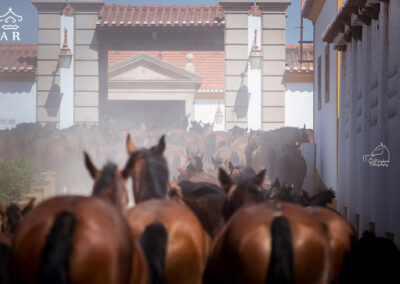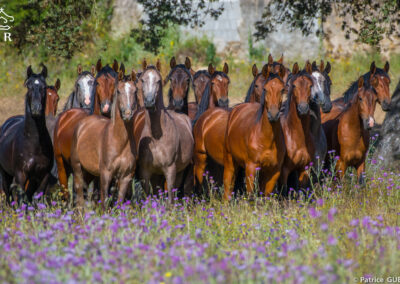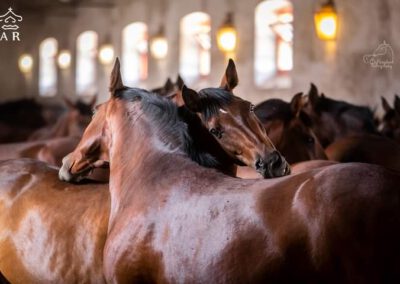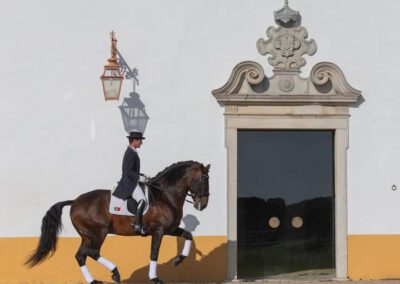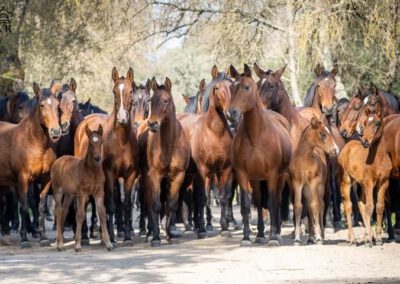Coudelaria de Alter State Stud
Portugal
Alter Real State Stud (Coudelaria de Alter)
Following the trend already spreading in other Royal Houses in Europe, the King D. João V of Portugal decided to breed his own horses for his and his pairs’ entertainment and pleasure. In result, on the 9th of December of 1748 he declared the foundation of the Alter Real Stud Farm, created with the goal of breeding bay horses for the service of the Royal Court. 276 years later, Alter Real (AR) Stud Farm is one of the oldest stud farms in the World and the eldest one still in function without ever changing its location.
In 2013, attempting to confer stability and to reduce costs’ impact of the State Stud Farms on public expenses, it was decreed that these studs should be under the care of Companhia das Lezírias, S.A., a resolution that has been a challenge but so far proved right.
During the last 20 years the evolution of breeding standards and the increasing demands for more sportive horses, more athletic and lighter than the typical Baroque horse performing in the Portuguese School of Equestrian Arts (EPAE), forced AR Stud Farm to face the need of accompanying these raising demands. Luckily Alter had the genetic assets required to breed AR horses with the characteristics demanded for the two different finalities, the baroque horse for EPAE, and the dressage athlete that is competing in the international arenas.
In 2023, two riders from Alter Real Stud Farm were representing Portugal and the Stud in the European Championships at Gran Prix – Under 25 level.
Coudelaria de Alter State Stud
Tapada do Arneiro
7440-152 Alter do Chão
The “AR” herd
The first group of bay mares, with which the “AR” brand started, was purposely acquired in Spain in 1748, because there wasn’t at the time difference between Lusitano and Pura Raza Española breeds, both known as Iberian horses. Around the mid 1800’s and due to the political instability in Europe, the “AR” herd “suffered” the introduction of different bloodlines, such as from Arabian and Berber horses, more apt for other kind of work, leaving the breeding of the pure “AR” in second plan and with very reduced number of specimens.
14 animals guaranteed AR bloodline’s recovery, which was considered “safe and stable” in 1979, when the project evolved for selection and improvement of the bloodline.
The National Stud Farm and the “CN” herd (Coudelaria Nacional)
The National Stud Farm was founded in 1887, under the name Southern National Stud Farm, and in 1890 absorbed the services of the Northern National Stud (in Quinta de Bencanta – Coimbra).
Nowadays, the National Stud Farm herd counts with 7 Arabian mares that descend from the mares acquired in 1903, 15 Lusitano mares and 20 Sorraia mares. It has, since its settlement, contributed with several animals for the “Stallion Bank”, where other breeders may use the stallions to improve their herds/lineages.
The Sorraia – “CN”
The Sorraia is an autochthonous breed, and the name represents the local where a group of these horses was found, near the valley of the river Sorraia. The recovery of this breed is owed to Dr. Ruy d’Andrade, who was responsible for the creation of the first Sorraia breeding “centre”, and from where all the specimens known to date descend from.
In 1975 the herd was put under the care of the Alter Real Stud Farm and later transferred to Font’Alva, a property of the Andrade family, to whom the horses belonged.
The Sorraia is typically a small horse (≤ 1,50m at the withers), proportioned and harmonious, and a subconvex face profile.
Surviving and thriving in extreme conditions and limited food resources, the rustic and resilient Sorraia may have a fundamental role in the preservation of nature and of natural ecosystems, where the majority of the modern breeds wouldn’t be able to cope.


